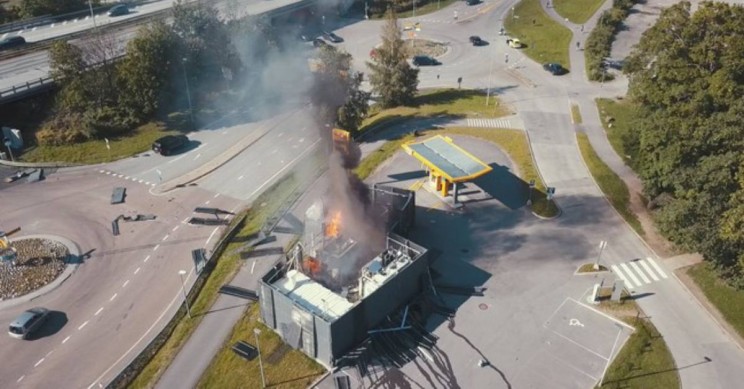Producing hydrogen gas using chaotically intermittent wind and solar is only the latest hoax being peddled by renewable energy rent seekers and other crony capitalists.
The majority of hydrogen available on the market (around 95%) is produced from fossil fuels by steam reforming or partial oxidation of methane and coal gasification with only a tiny fraction produced by way of biomass gasification or the electrolysis of water or solar thermochemistry.
Steam-methane reforming, the current leading technology for producing hydrogen in large quantities, extracts hydrogen from methane, usually in the form of natural gas; the process releases carbon dioxide and carbon monoxide into the atmosphere. Which, of course, doesn’t wash with the climate cult.
Another method of creating hydrogen is electrolysis, which involves chewing up enormous volumes electricity that gets passed through a volume of water to separate the hydrogen and oxygen atoms. The big plus attached to this method is said to be that burning hydrogen gas does not release carbon dioxide gas.
Renewable energy rent seekers have seized on the concept of producing hydrogen gas using wind and solar as a way of converting useless, unpredictable and unreliable electricity into something that can be used as and when consumers need it; rather than something that depends on the whims of mother nature.
If producing industrial volumes of hydrogen using electricity were even vaguely economic, then the obvious way of doing so would be to use coal-fired power; the cheapest and most reliable power source, of all.
But that’s not the point and purpose of the great hydrogen hoax. This is about corporate greed and rent seeking.
The rules of physics (not least thermodynamics) means that, whatever the power source, more energy will be expended than will ever be returned from the process of turning electricity into hydrogen gas, storing and distributing it. Which means it will not result in a net energy benefit.
Because the whole thing is a pipe dream, no one pushing the “let’s turn wind and solar power into hydrogen” line has bothered with the Energy Return On Investment or EROI – the ratio between the energy delivered by a particular fuel source to society and the energy invested in the capture and delivery of that energy.
Oh, almost forgot to mention a couple of other laws of physics – the storage and distribution of hydrogen gas is not without its challenges. Attempting to contain the gas in large volumes comes with the threat of industrial scale explosions, thanks to its low ignition point and highly combustible nature, and also because it tends to leak easily from tanks. More than a few hydrogen storage facilities and filling stations have exploded – as to which, see below the image from Norway where one went up with one hell of a bang.
Putting aside the threat posed by large-scale distribution and storage of a highly flammable and volatile substance, let’s return to the economics.
Perhaps the most obvious hint that turning wind and solar power into hydrogen gas makes no economic sense, is that those promoting it are demanding taxpayer subsidies, from the get go. And, as with those who profit handsomely from subsidies for wind and solar, these characters are not suggesting an end date for those subsidies – at least anytime between now and kingdom come.
Of course, if producing hydrogen gas from electricity was a profitable enterprise there would be plenty of firms already hard at it, rather than spending all their efforts on pressuring governments to open our wallets.
Alan Moran picks up the theme below.
Gassed-Up and Light-Headed for Hydrogen
Quadrant Online
Alan Moran
11 May 2020
There can be no doubting the reversion of businesses’ political advice to self-interested advocacy, in contrast to the glory days of 40 years ago. At that time there was a strong push for deregulation, but industry leaders have since backslid into promoting their particular interests, seeking subsidies (especially for energy) and, not unrelatedly, virtue-signalling to deflect NGO criticism and its associated damage to share prices. I have a piece in The Spectator that addresses this.
The advice from businesses and their representatives is now best politely ignored. Firms will virtue-signal but in acting on the advice they proffer – usually focussing on calls for some form of carbon tax – they face the test of the marketplace. As I note, business success is dominated by iron laws of profit. Those leaders who implement measures that veer too close to the quicksands of virtue-signalling will be swallowed by it.
In today’s AFR, the superb Joe Aston illustrates this by focussing on Rio Tinto which, having sold its coal interests, has recently assumed the pole position among the climate alarmists. Rio is, with Shell and BHP, dominant among the international Energy Transitions Commission (ETC) which this month has called for government “to build a healthier, more resilient, net-zero-emissions economy, that drives sustainable economic prosperity”. But this gambit also seeks a $100 per tonne carbon tax (Gillard’s was a mere $23 per tonne). Previously, Rio has favoured such a tax but — Surprise! Surprise! — not for export-oriented industries. Aston exposes their hypocrisy, and Rio has retreated to say that it does not support all the ETC measures its chairman has only just signed up for!
The cackle of business opinions calling for carbon taxes is fuelled today by a drivel report, “Start with steel” from the Grattan Institute, gushingly publicised in the renewable energy industry’s client news media such as Nine’s newspapers and the Guardian.
The Grattan report first rehearses all the dire alleged consequences — floods, droughts, loss of Great Barrier Reef, heat waves etc — that will beset Australia if we do not do our bit in suppressing carbon emissions. It moves on to promote the latest alarmist tech fad, hydrogen, as the energy source of the future but stays sufficiently grounded to recognise that, even using the most heroic cost assumptions, this will add 25 per cent to the price of steel. Notwithstanding this, Grattan perseveres with the fanciful arithmetic to arrive at the desired conclusion of Australia putting itself in a position to capture 7 per cent of the world’s steel market, up from one per cent today. Grattan does not reveal why its projections stops at 7 per cent, rather than, say, 37 per cent.
Grattan’s solons claim that harnessing all our wind and solar assets would make Australia an “Asian energy superpower”. Two problems with this: first, these assets will never provide cheaper and more reliable energy than coal and, secondly, Australia does not have especially good wind assets while its solar strengths are in the dead centre, where nobody lives and whence the transmitting of power could be done only at exorbitant cost.
Predictably, Grattan rounds out its pathetic analysis by saying, “Governments should act now” if we are to reach energy Nirvana. It calls for subsidies and funding of “pre-commercial studies”, confusingly arguing that such measures will avoid having to impose a $20-30 per tonne carbon tax. Nobody apparently asks why, if wind, solar and hydrogen are so competitive, we would need a carbon tax to throttle coal’s competitiveness?
Quadrant Online



Translated and reblogged it on https://www.eike-klima-energie.eu/
“Wasserstoff Hoax: Wind- und Solarprofiteure fordern Subventionen, um ihre chaotische Energie in leichtflüchtiges Gas umzuwandeln”
Thank you
Reblogged this on ajmarciniak.
Just so we are clear on this, the plan is to use the electricity from solar/wind plants (backed by coal/gas) to produce hydrogen and we then fill the tanks of our cars with the stuff at 700 bar to produce electricity so we can feel all warm and fuzzy because we are reducing our emissions by driving electric vehicles?
Is there not one person amongst this crowd with a modicum
of common sense? Do they not understand the physical limitations of storing H2 at 700 bar? Do they not remember the Hindenburg?
Its like “i reject your reality and substitute it with my own”
JESUS F*&^%$$ING WEPT
One economic factor that is always ignored in these proposals to use intermittent wind/solar power for some industrial process is the capital expenses.
In other words, the equipment to isolate hydrogen, or the equipment to desalinate water, or whatever the fantasy of the month is, all that equipment costs money. Usually lots of it and the more efficient the equipment, typically the more expensive.
When you have expensive equipment, you want to get the most use out of it you possibly can, to lower the unit cost of whatever you’re producing.
If you power your expensive equipment with intermittent wind/solar, then 70 of the time, at least, you will not be operating said equipment. That expensive rig will be sitting idle.
This make no economic sense. If hydrogen is a magical solution to energy storage or transportation chemistry, then power it with clean, reliable nuclear energy, which will keep the equipment operating 100% of the time.
Truly, any “backup” system or conversion system proposed for wind/solar would work at least four times better when paired with nuclear and nuclear would need less of it.
With all the conversions from Sun and wind and coal and wave with gas back up why not go straight to Nuclear powered cars running a small water cooled reactor producing the steam for an advanced Pritchard steam engine. With all the rubbish being written and thought up in focus groups about highly technical intricate advanced engineering while the world still relies on a piston engine first built in the 1880’s and hasn’t changed since and Electricity generated and carried by cables from the same era surely the Geniuses at the “Guardian” or the Boy wonder Angus Taylor could come up with something nearing 100% efficiency. For ease of production and an endless supply the bullshit and rubbish that comes out of the mouths of Australian politicians and the vast majority of the Australian population who are engineering illiterate and have trouble turning on a GPO or filling their cars with petrol should fuel Australia for centuries.
This website is an antidote to the propaganda spouted everywhere else. One site in particular – http://www.reneweconomy.com pushes RE nonsense more than any other website. They’ve been touting grid batteries and hydrogen as a perfect alternative for FF generators. Furthermore, they repeat over and over again that RE is now cheaper FF but yet no market in the world reflects this.
Reblogged this on uwerolandgross.
Green activists never let science get in the way of their agenda.